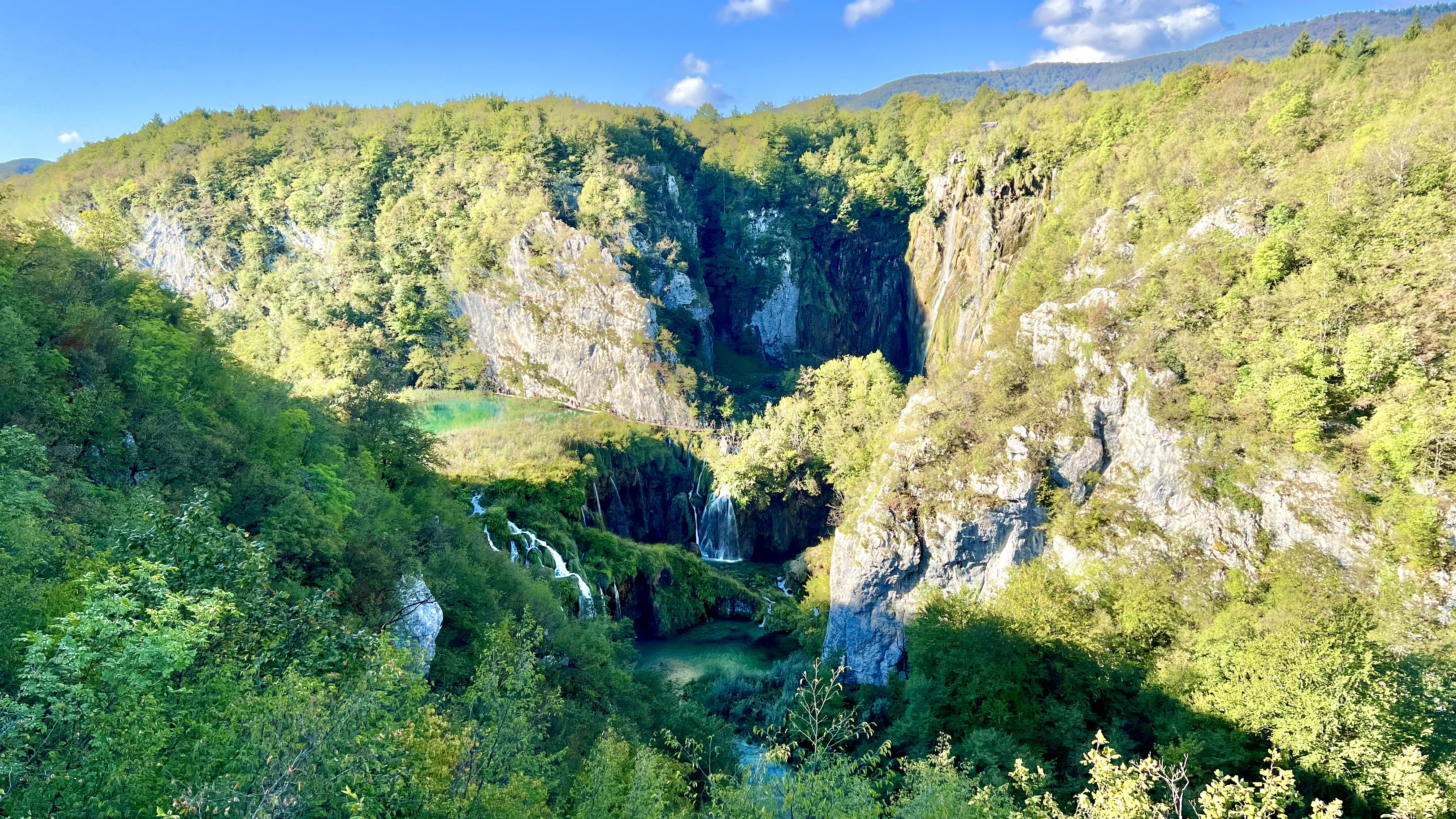
Table of Contents
There’s one thing you should never do in Croatia’s stunning Plitvice Lakes National Park. And no, it’s not refraining from feeding the wildlife. However, it would be best if you didn’t do that either.
The correct answer, or perhaps the most important if you value life and limb, is to stay on the well-marked trails within this UNESCO Heritage Site once known as The Devil’s Garden.
Date of Visit: September 23, 2022
We were officially lost within the 116 square miles of pristine lakes, waterfalls, and forest encompassing Plitvice Lakes National Park in Croatia. I don’t mean to sound melodramatic; panic was far from necessary. It wasn’t the kind of “lost” where loved ones implore authorities to send out search parties.
There was no need to consult a compass (a handy one resides on your iPhone). And we certainly didn’t need to navigate using lichen (they cling to stones on the southern side). Sorry, Dad, that old boy scout trick has yet to come in handy.
To put things in perspective, day hikers from every country imaginable were streaming past us like a United Nations parade, going to and from seven well-signed routes between the 16 lakes.
Walking The Plank
Embarrassingly, Chris and I were on one of the well-worn wooden plank pathways meant to guide us. In our confused state, I wondered how the Habsburg and Ottoman armies managed when they battled each other here hundreds of years before these modern contrivances. When Plitvice was still a wilderness, some called it The Devil’s Garden, perhaps because of the Turks or the legends of mystical forest creatures it inspired among the ancients.
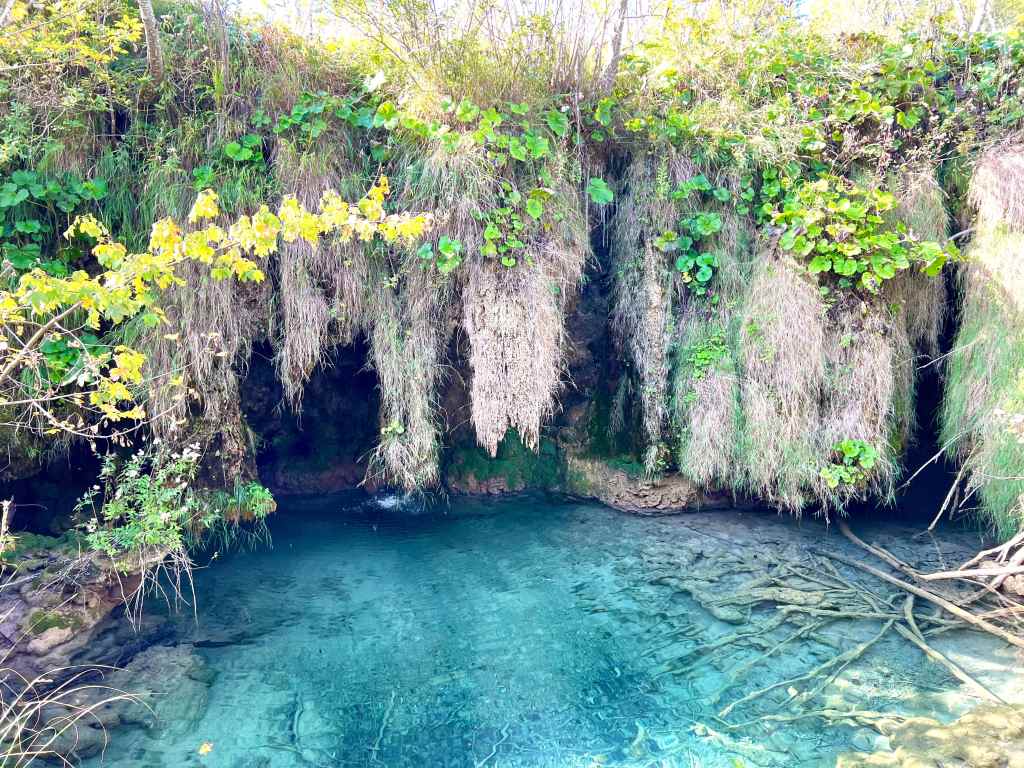
The fact is that we needed to correct our course. Our hired driver, Frane’s, instructions were simple. We were to spend 3 1/2 hours hiking, after which we would meet him at the Hotel Jezero parking lot near Entrance 2. The plan was to travel 2 1/2 hours by car to the seaside town of Split that day.
We could have backtracked, but that would make us late. That led us to a rash decision. But before I tell you what that was, let me backtrack my story to give you some insight.
The Starting Gate
Several hours earlier, we arrived at Entrance 1 to begin our hike. We were there about 15 minutes after the park opened at 9:00 am, yet a mass of surging humanity was already gathering to beat the crowds.
It’s no secret that Entrance 1 is an impressive starting point with a panoramic view of The Big Waterfall (Veliki Slap) and Sastavci waterfalls plunging into the Lower Lakes.
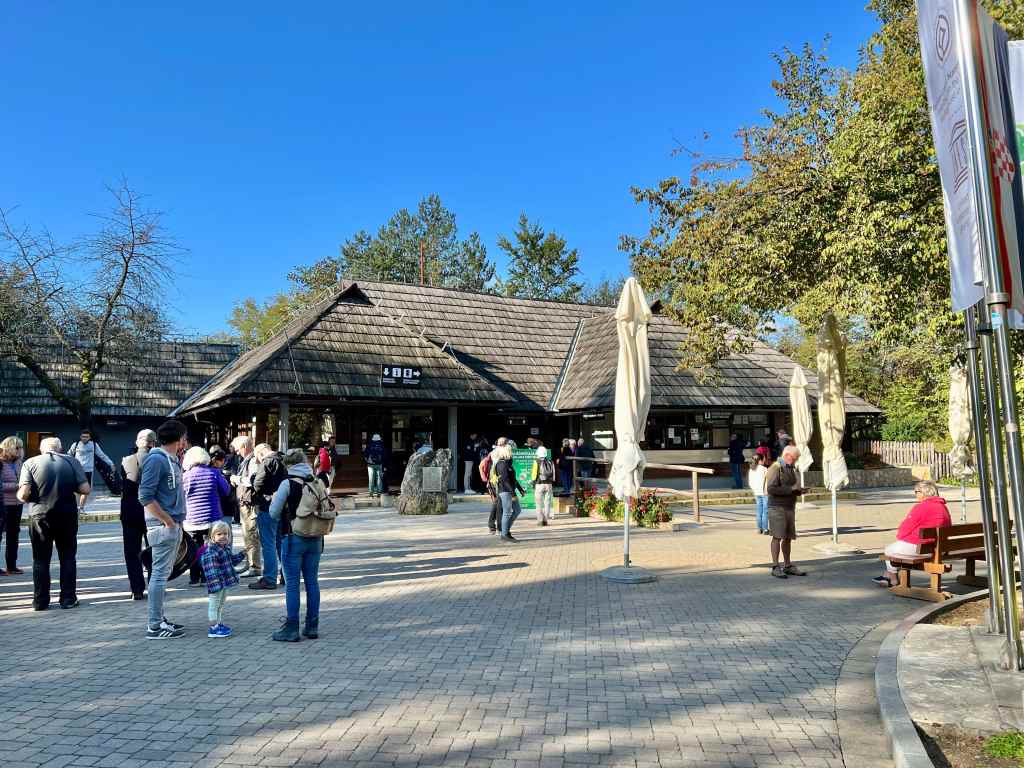
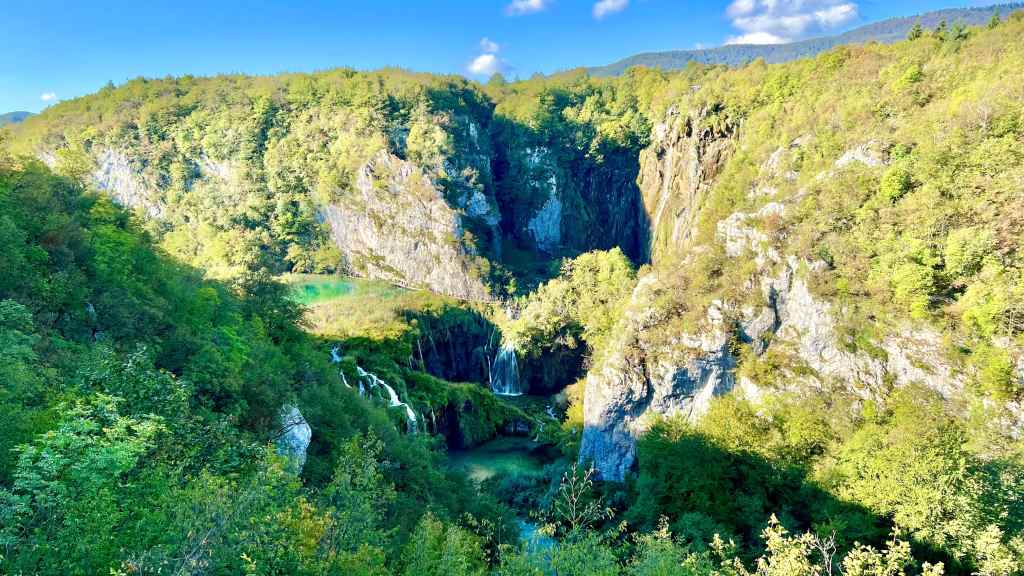
At 78 meters high (nearly 256 feet), Veliki Slap is the largest waterfall in Croatia. It is just one of the many reasons that the park became a UNESCO Heritage Site in 1979.
We jockeyed for the best selfie shots with the pouting and puckering budding social media influencers. My five-foot selfie stick proved handy as I dangled my iPhone high above their heads to get a picture.
By the way, I love this selfie stick because it has a wireless remote shutter and it always works! It’s $21.99 on Amazon, and if you buy it, I won’t get a penny because I just got booted out of the Amazon affiliates program for not selling anything in 180 days).
Plitvice Lakes National Park Rules
Before heading down the path to the lakes, we scanned the large trail map and dutifully read the park rules. Aside from the usual guidelines we’d expect to see in California — do not feed the animals, no swimming or fishing, do not throw garbage—a few seemed uniquely Croatian:
- No collecting plants
- No shouting
- No walking off the track
- No damaging trees
- Do not damage rocks
That was all fine with us. I did not intend to feed the squirrels or dormice that forage in the forest. And I certainly wasn’t going to engage with the brown bears and wild boars deep in the interior. I had read that wolves were back in the park, so it seemed prudent to keep a low profile—no need to become the Daily Special if I wanted to enjoy one myself that night. Best to let the forest critters eat the beech nuts.
Various Hiking Options (Map)
With my right leg swollen twice its size from the previous day’s riding accident, 3 1/2 hours seemed plenty to walk the planks on the water’s edge and wander the paths through the forests. The shortest route takes two hours, and the most circuitous route, winding around the Upper and Lower lakes, takes eight hours. Thanks but no thanks.
Hordes of Nature Seekers
Enjoying the park with so many other tourists would be challenging. So, somewhat disheartened, we followed a long line of people down a narrow path to the water. They seemed to be multiplying by the minute.
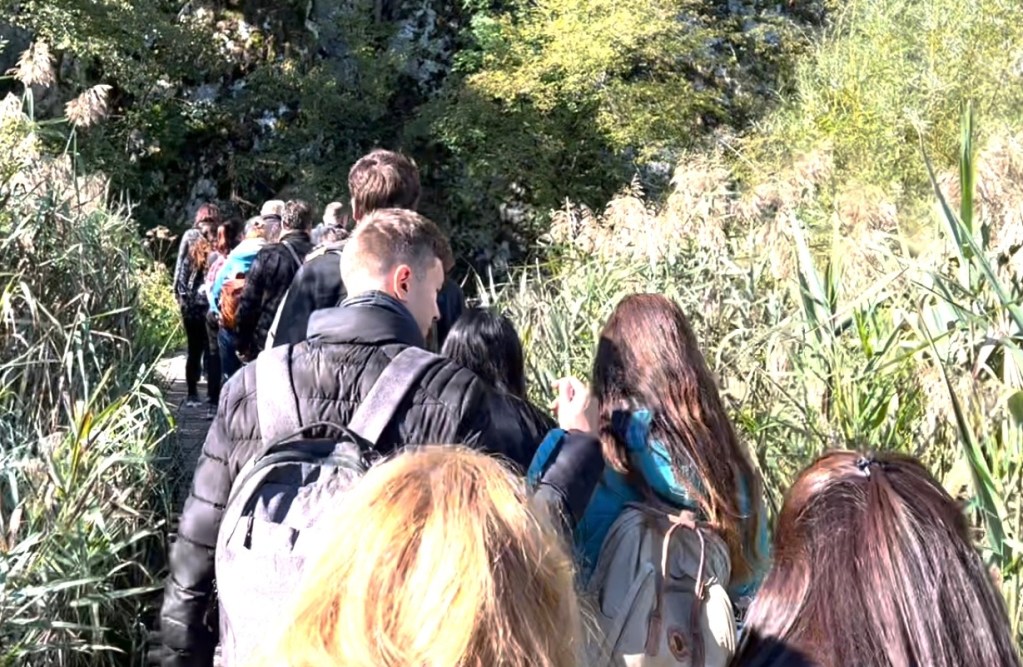
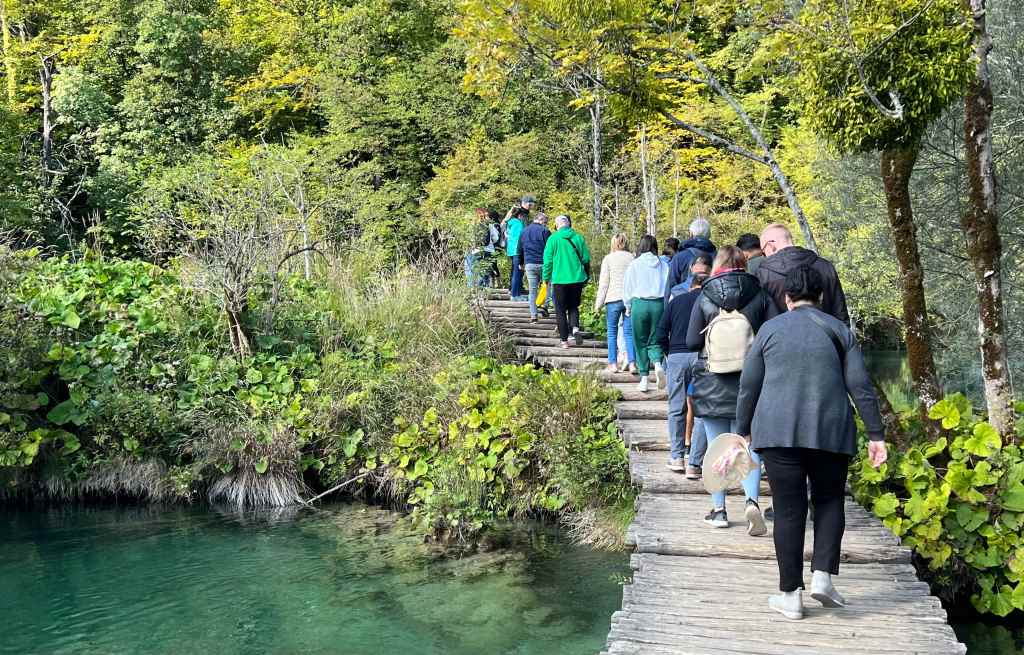
Since the post-Covid lockdown, I have read that Europe is seeing tourism spikes in the triple digits, and Croatia is no exception. More than one million descend on Plitvice Lakes each year. It was late September, considered shoulder season, and everyone and their mother was visiting.
Fortunately, as we walked, the crowds began to disperse among divergent trails, and the enchanting scenery, no longer obscured by coats and backpacks, enveloped us.
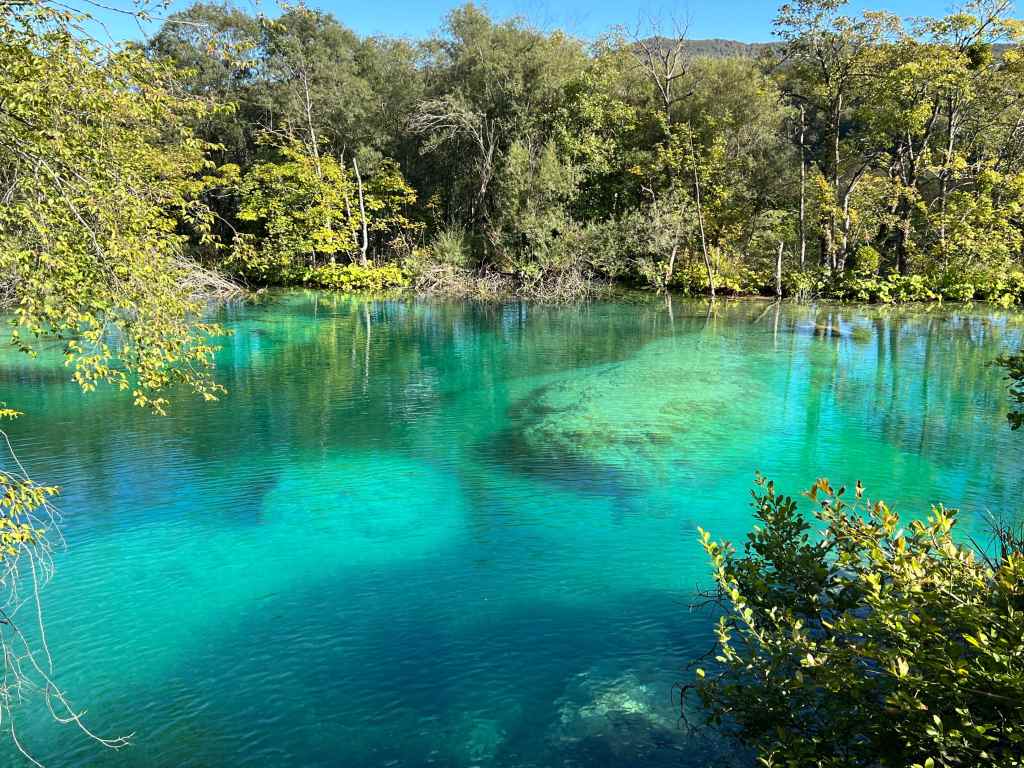
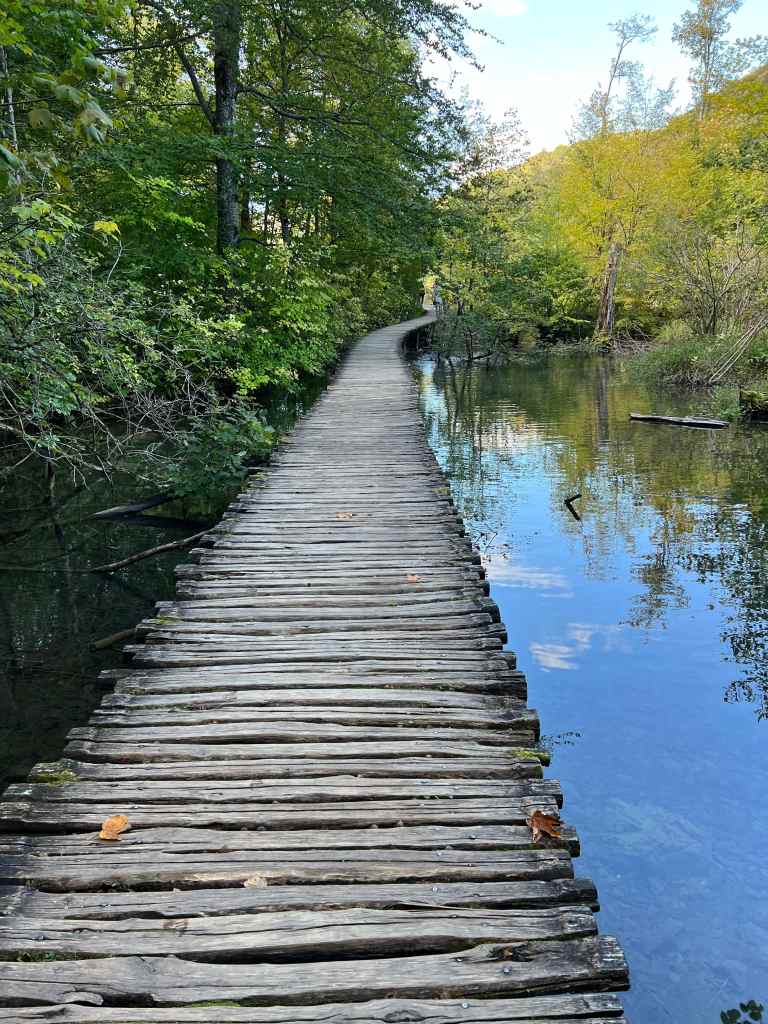
My Video
Our Route
We passed the glassy lower lakes of Kaluđerovac, Gavanovac, and Milanovac and headed to the large upper lake Kozjak. The lakes were crystalline blue, and small schools of fish swam near the banks.
We walked shady paths and through a beech forest. We passed waterfalls and rushing streams with the surround sound of water in our ears. The beauty of the lakes unfolded in nature’s harmony.
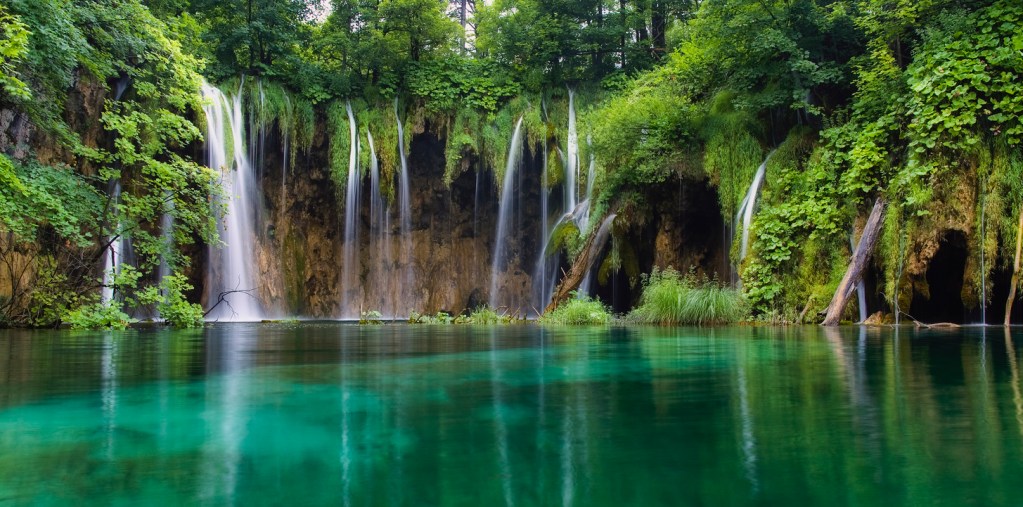
A covered electric boat took us on a southern route from P3 to P2, where we disembarked to walk north along the edges of Gradinsko Lake and up to Galovac Lake.
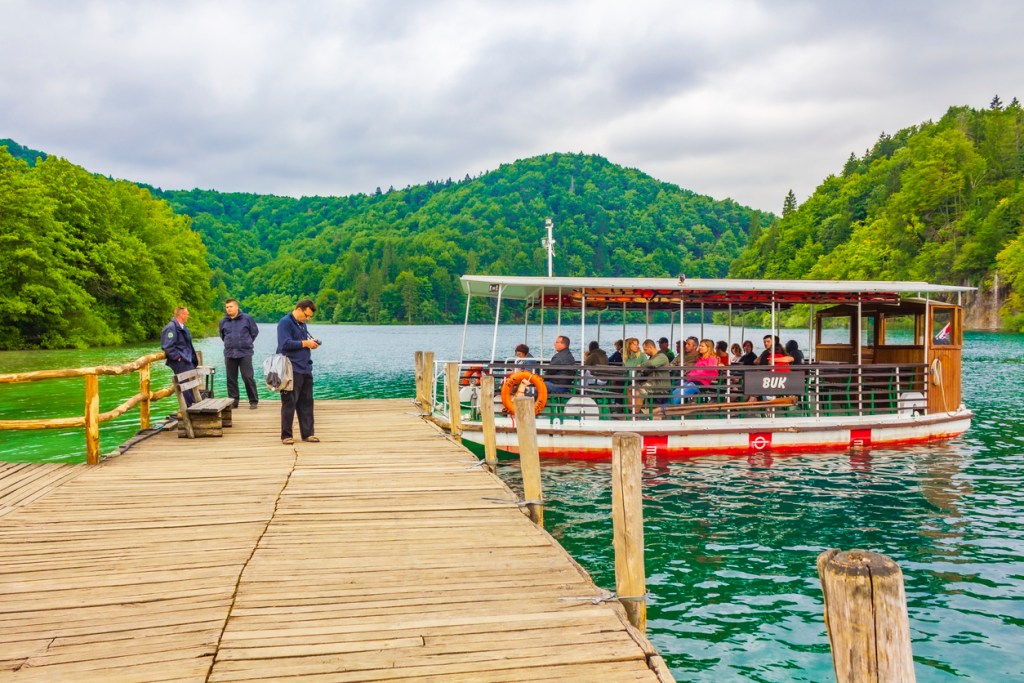
Off The Beaten Path
Three hours in and many photos later, we realized we had walked the planks too far in the opposite direction of our designated meeting spot. Now we had 45 minutes left to find Frane.
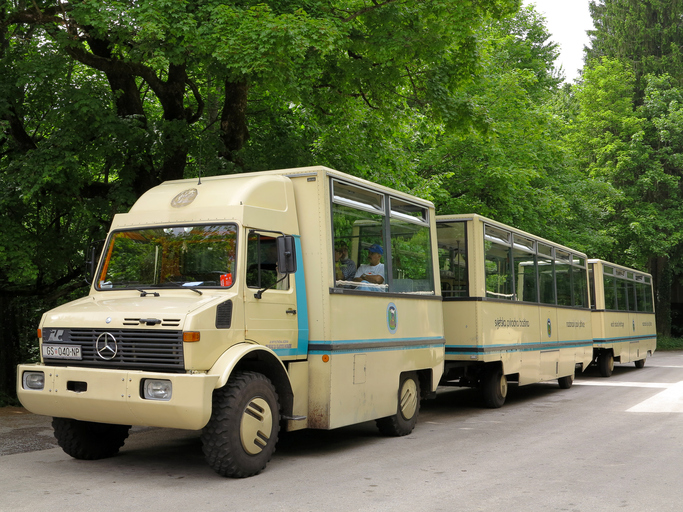
“Let’s climb to the road above us,” Chris suggested.
We had noticed a few buses passing overhead every 15 minutes or so on an interior park road. Our initial thought was to flag one down.
We decided to bushwhack a path through the woods toward the road.
Bushwhacking Is Ill-Advised in Plitvice Lakes
Unfortunately, our diversion would prove to be the longer way around. Several “panoramic trains” (they are buses) passed us. But they would only stop at their two designated pick-up and drop-off spots miles away.
The road wound high above the lake, then dipped and backtracked before crossing a stream to enter the hotel zone. We considered going off track again to meet up with the other side of the curved road.
The undergrowth was dense, so we stuck to the long, winding road. In hindsight, it would have been quicker and wiser to retrace our steps from Lake Galovac to P2. From there, a short ferry ride would have taken us to P1, near our meeting spot. (See park map above).
A Modern-Day Devil's Garden
By the time we met Frane, we were a little weary but had plenty of time to spare. When I researched Plitvice Lakes for this travel story months after our return, I realized how dangerous our little off-road escapade was.
Once again, there is good reason to call the area a Devil’s Garden.
It’s not the bears, boars, or wolves that pose a risk. As usual, it is humans.
The Croatian Serbs and Croats laid landmines throughout Croatia, including in Plitvice Lakes National Park during the Croatian War of Independence from 1991 to 1995.
The park was the epicenter of a violent clash between Croatian Serbs and the police force that kicked off the devastating war on May 19, 1991. (See Roadtripping on the Balkan Peninsula and Visit Croatia).
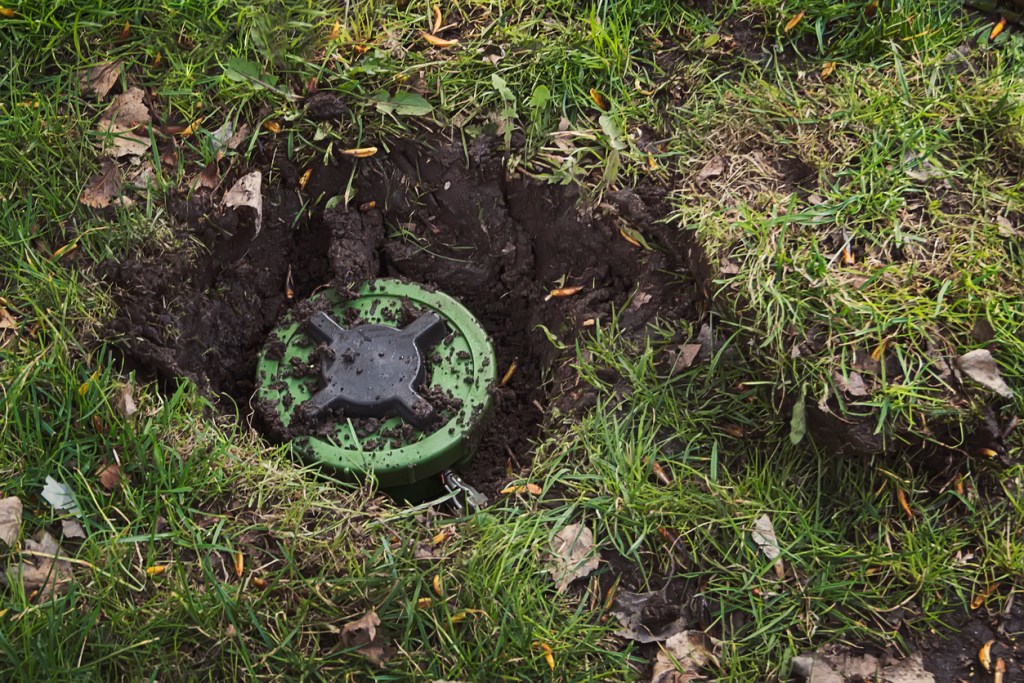
A Local Hero in My California Neighborhood
Credit for some of Croatia’s mine-clearing successes goes to my neighbor, Heidi Kuhn, whose non-profit, Roots of Peace, was involved in fund-raising for mine-clearing throughout Croatia.
Her efforts, along with the support of Californian vintners, Croatian-born Miljenko “Mike” Grgich of Grgich Hills Estate, Robert Mondavi, Tor Kenwward (Beringer), and Eric P. Wente of Wente Family Estates, helped restore vineyards abandoned during the war. Roots of Peace estimates there were once 1.2 million landmines planted in vineyards between the Danube River and the Dalmatian Coast.
Inspired by the late Princess Diana’s mine-clearing charity work, Heidi and Roots of Peace have cleared mines to restore land for agriculture in Afghanistan, Angola, Bosnia-Herzegovina, Cambodia, Croatia, Iraq, Israel, Palestine, Vietnam, and Zimbabwe.

One More Rule
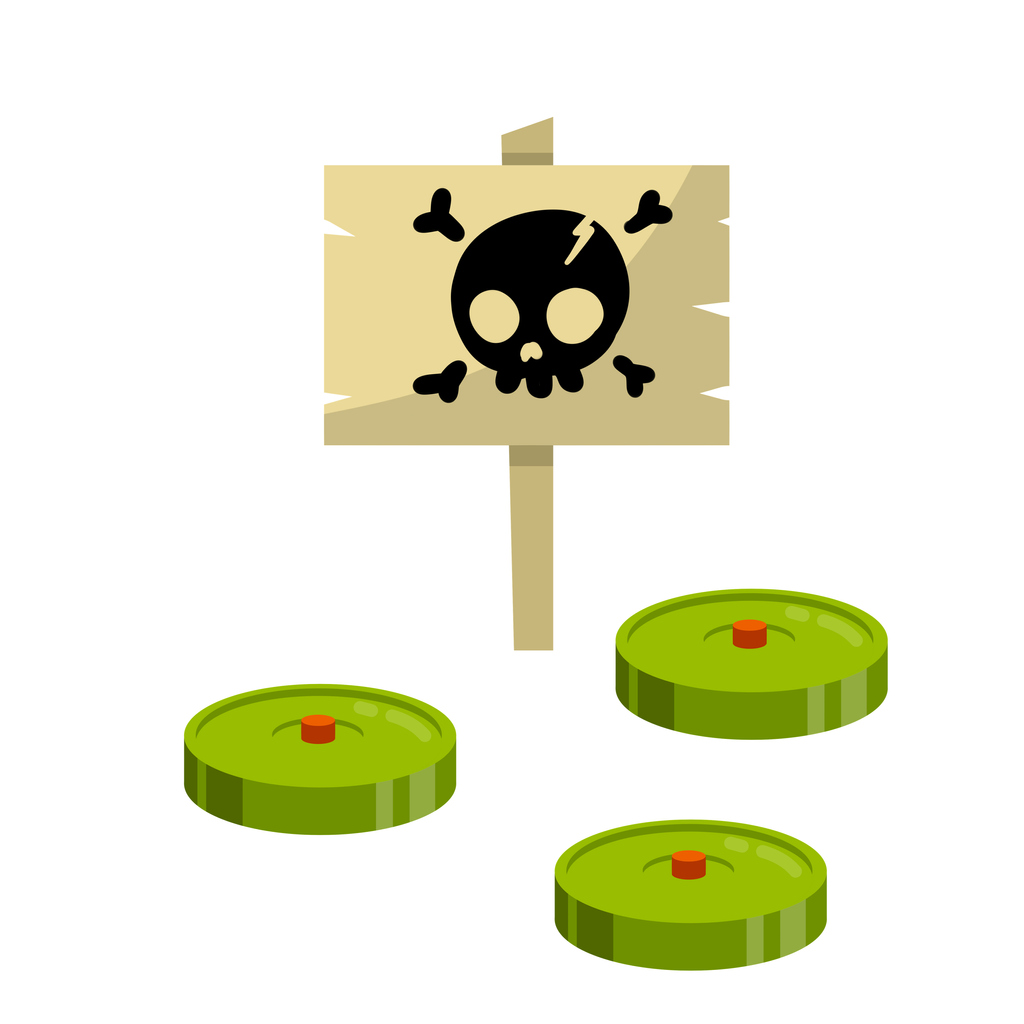
As a tourist attraction, Plitvice Lakes National Park underwent extensive mine-clearing early on. It was declared safe, and only the park’s more remote areas may present risks as adventure tourism picks up.
Nonetheless, I suggest the park staff at Plitvice Lakes add one more rule to their wooden signboard: “Watch Out for Landmines.” A ticking bomb icon next to the “No walking off the track” rule would also discourage clue-less would-be off-roaders.
Recommended Route
- Enter Entrance 1 for a panoramic view of the Big Waterfall (Veliki Slap) and Sastavci waterfalls.
- Walk to the Big Waterfall
- Walk from the Big Waterfall to the boat pier (P3)
- Take a boat ride across Lake Kozjak to P2 (20 mins).
- (Optionally) Walk from P2 to the Upper Lakes and return to P2).
- Take a short boat ride from P2 to P1
- Walk to Entrance 2.
Before You Go
Buy your tickets in advance at the park’s official online ticketing site. At the National Park website, you can check current conditions and alerts. Remember to download the official map: another option, photograph one of the large posted maps at the two park entrances.
Plan your route. There are seven suggested routes to explore the Upper and Lower Lakes, each marked with a “P” for Program.
Consider going off-season to avoid the crowds.
And remember the most important rule: “No walking off the track.”
This article is the 12th in my 19-part Balkan series, which began with ‘Road Tripping on the Balkan Peninsula’ in September 2023. There, you will find our itinerary to help you plan your trip.
- Ratings are based on 1) Natural Beauty 2) Unique Activities 3) Old World Charm

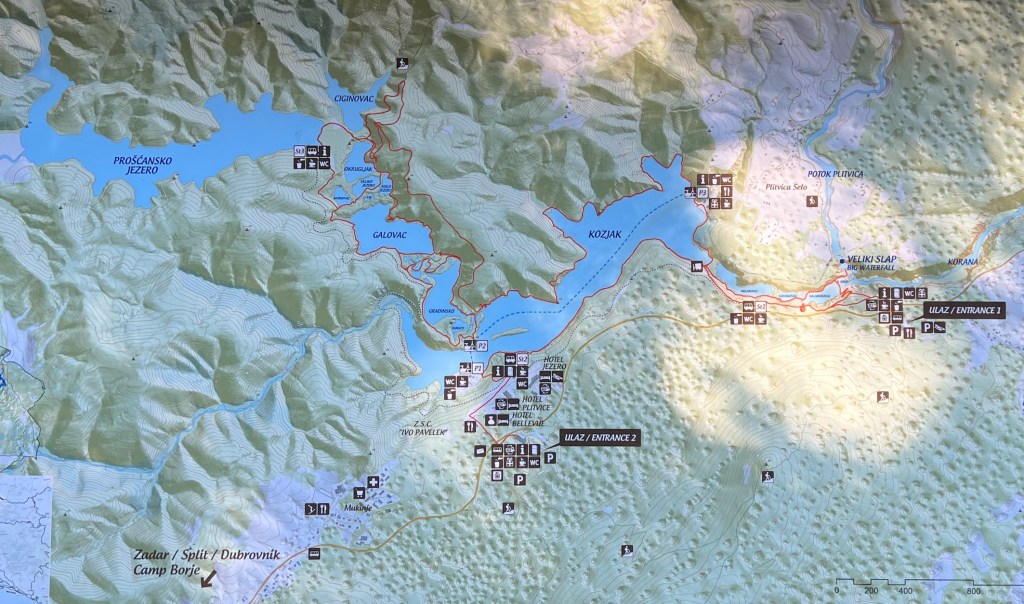
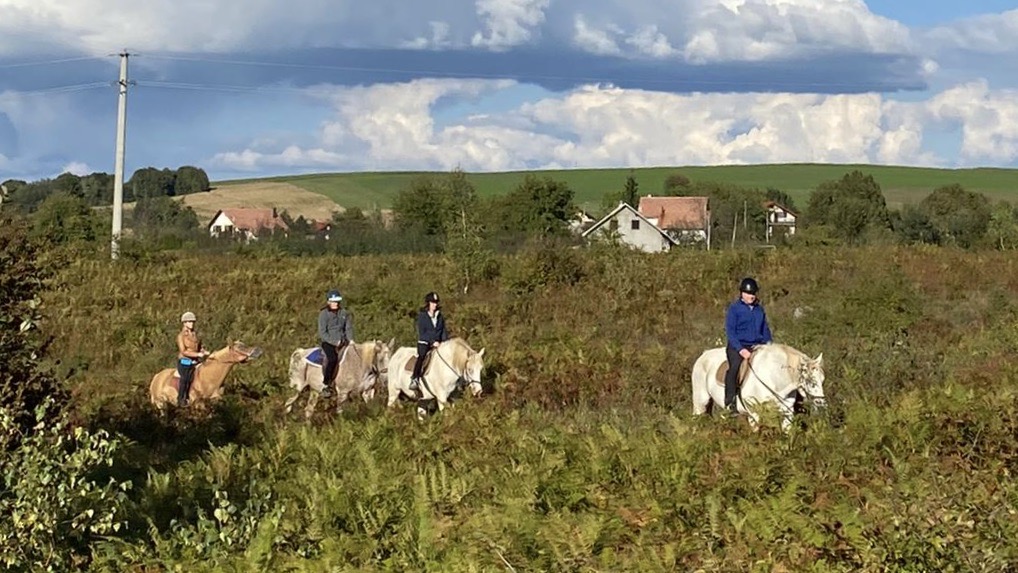
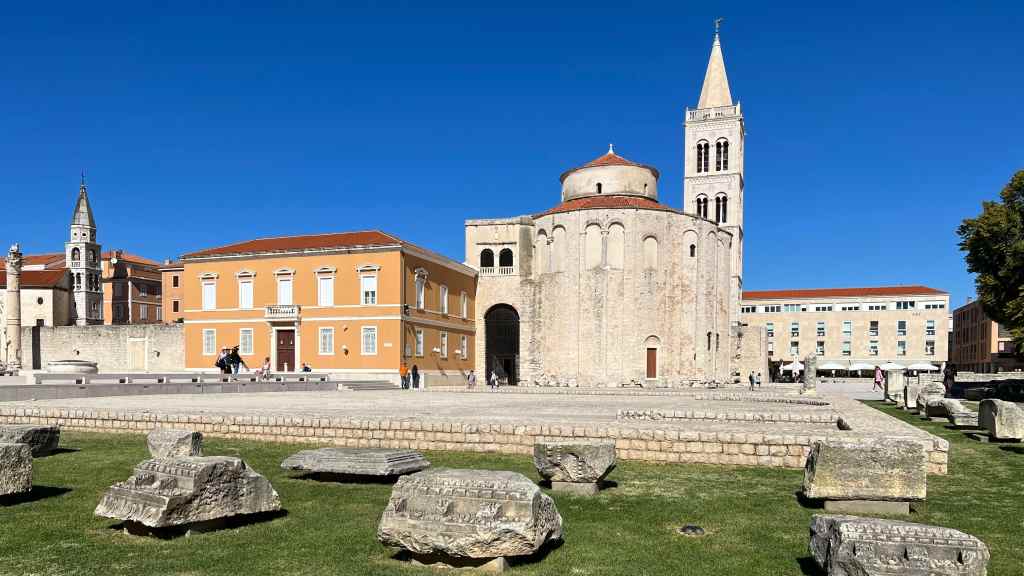










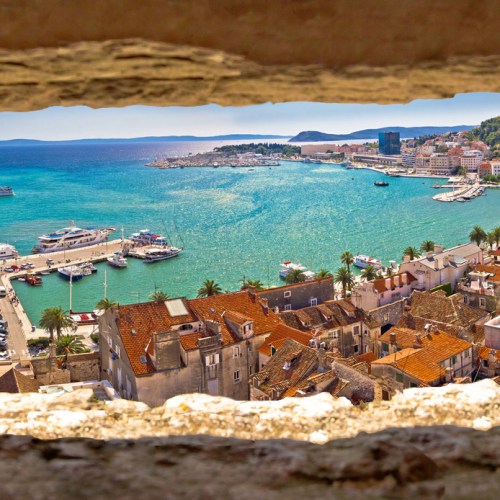
2 Comments
Well it’s certainly a gorgeous park to get lost in! Although hiking with that many other people makes less enticing for me, but you were able to get great people-less pictures 🙂 Maggie
Thanks, Maggie. Traveling is a challenge these days with the crowds. I’m sure, weather-permitting, there are better times to visit Plitvice Lakes, but we didn’t expect this many people during shoulder season. Not surprisingly, we were the only ones who went off trail. I guess everyone else knew about the possibility of landmines.
Discover more from Travel The Four Corners
Subscribe now to keep reading and get access to the full archive.
Continue reading